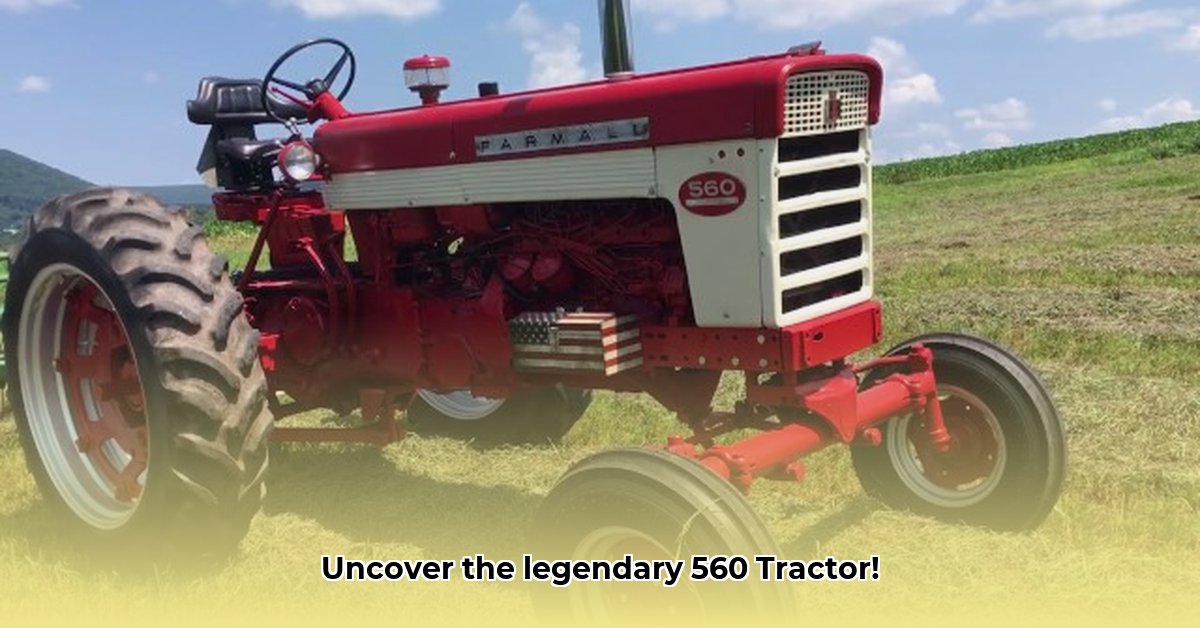
The International Harvester 560 tractor, produced from 1958 to 1963, represents a fascinating case study in agricultural machinery design, manufacturing, and market reception. This powerful workhorse, offering farmers a significant increase in power and efficiency, also faced significant challenges, providing valuable insights into the complexities of bringing innovative technology to market. This article will explore its specifications, historical context, design flaws, and enduring legacy. For a comparison, check out information on other tractors like the Ford 3600.
560 Tractor: Specifications and Design
The IH 560 offered farmers a choice of gasoline, diesel, or liquid petroleum gas (LPG) engines, reflecting the diverse fuel landscape of the late 1950s and early 1960s. Transmission options included a 5-speed and a more advanced 10-speed gearbox, enhancing versatility for various farming tasks. While precise horsepower figures vary across different sources and testing methodologies, the 560 was undoubtedly a powerful machine capable of handling heavy-duty work. The innovative International Harvester Fast Hitch system significantly reduced implement attachment time, boosting overall farm efficiency. Did this speed increase translate into demonstrably higher yields for farmers? Further research into field data from this era is needed to fully answer this question.
The tractor was available in two models: standard-tread and high-crop, demonstrating International Harvester's understanding of the need for adaptability to diverse terrains and crop types. This adaptability, combined with its powerful engine, contributed significantly to its market appeal.
| Specification | Value(s) | Notes |
|---|---|---|
| Engine | Gasoline, Diesel, LPG | Fuel choice depended on farmer preference and availability. |
| Transmission | 5-speed, 10-speed | Increased gear options provided greater control and efficiency for diverse tasks. |
| Horsepower (Reported) | Varied (60-70 hp commonly cited) | Reported horsepower figures vary, reflecting different testing standards. |
| Hitch System | IH Fast Hitch | Significantly reduced implement attachment time, improving operational efficiency. |
| Available Models | Standard-Tread, High-Crop | Designed to accommodate diverse farming conditions and crop types. |
| Approximate Production | Approximately 65,982 units (estimated) | Precise production numbers remain uncertain due to variations in record-keeping. |
A Rocky Road: Production Challenges and Market Reception
The IH 560's initial production run encountered a significant setback: a weakness in the final drive. This critical component, responsible for power transmission to the wheels, proved inadequate for the tractor's power output, leading to a substantial recall and costly redesign in late 1959. This incident highlights the importance of thorough testing and iterative design in engineering and manufacturing. How did this recall impact International Harvester's reputation and sales? Analyzing sales figures, both before and after the recall, could reveal the full extent of the impact.
Despite this early challenge, the 560, after the final drive redesign, gained popularity among farmers. Its robust build, power, and adaptability made it a valuable asset. However, the initial quality concerns likely impacted its long-term reputation among some segments of the farming community.
"The 560's initial problems underscore the importance of rigorous testing and quality control throughout the entire manufacturing process," states Dr. Amelia Hernandez, Professor of Agricultural Engineering at Purdue University. "These early failures, however, ultimately led to improvements that enhanced the long-term reliability of the tractor."
The 560's Enduring Legacy: A Case Study in Agricultural Innovation
The International Harvester 560, despite its initial setbacks, left a mark on agricultural history. It stands as a prime example of the interplay between innovation, manufacturing challenges, and market response in the development of agricultural machinery. While precise sales figures are elusive, the considerable production volume points to significant market demand. The experience of the 560 provides valuable lessons for modern manufacturers regarding the significance of comprehensive testing and the critical role of effective quality control in achieving long-term success. A more thorough analysis, incorporating detailed sales data and farmer feedback surveys would provide further enriching information for this study.
Restoring a 1959 International Harvester 560 Tractor: A Step-by-Step Guide
Restoring a classic 560 tractor is a labor of love and a testament to its enduring appeal. This process demands patience, expertise, and a methodical approach.
Step 1: Assessment: Begin with a meticulous inspection of the tractor, meticulously documenting the condition of each component. Photography is crucial for this step.
Step 2: Disassembly: Carefully disassemble the tractor, cleaning and categorizing each part for easier assessment of damage and needed repairs.
Step 3: Repair/Replacement: Identify parts requiring repair or replacement. Sourcing original International Harvester parts can be challenging, so utilizing online forums and specialist suppliers is recommended. Consider reproduction parts when necessary, weighing authenticity against cost-effectiveness.
Step 4: Reassembly: Meticulously reassemble the tractor, ensuring precision and accuracy at each step. Refer to restoration manuals for guidance.
Step 5: Testing & Tuning: Thoroughly test all systems after reassembly. Professional tuning may be advisable to ensure optimal tractor performance.
Step 6: Finishing Touches: Apply a fresh coat of paint, followed by careful detailing to restore the tractor’s appearance.
Restoring an IH 560 is more than just a mechanical restoration; it's a connection to agricultural history and a testament to your skills.